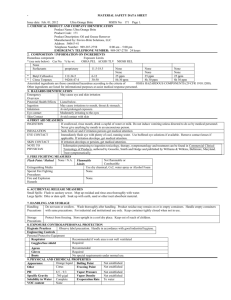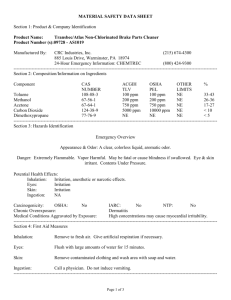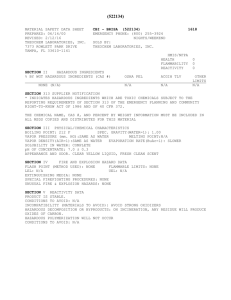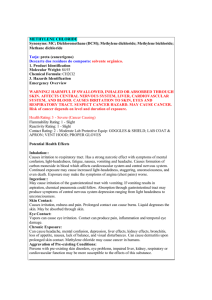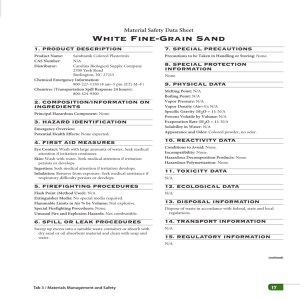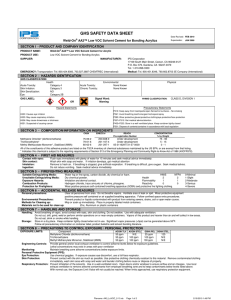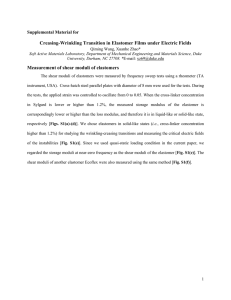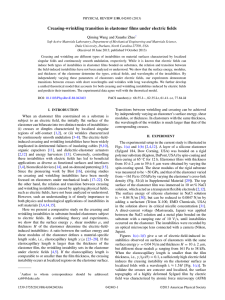MANUFACTURER Issue Date: May 2002 Elastomer Specialties, Inc
advertisement
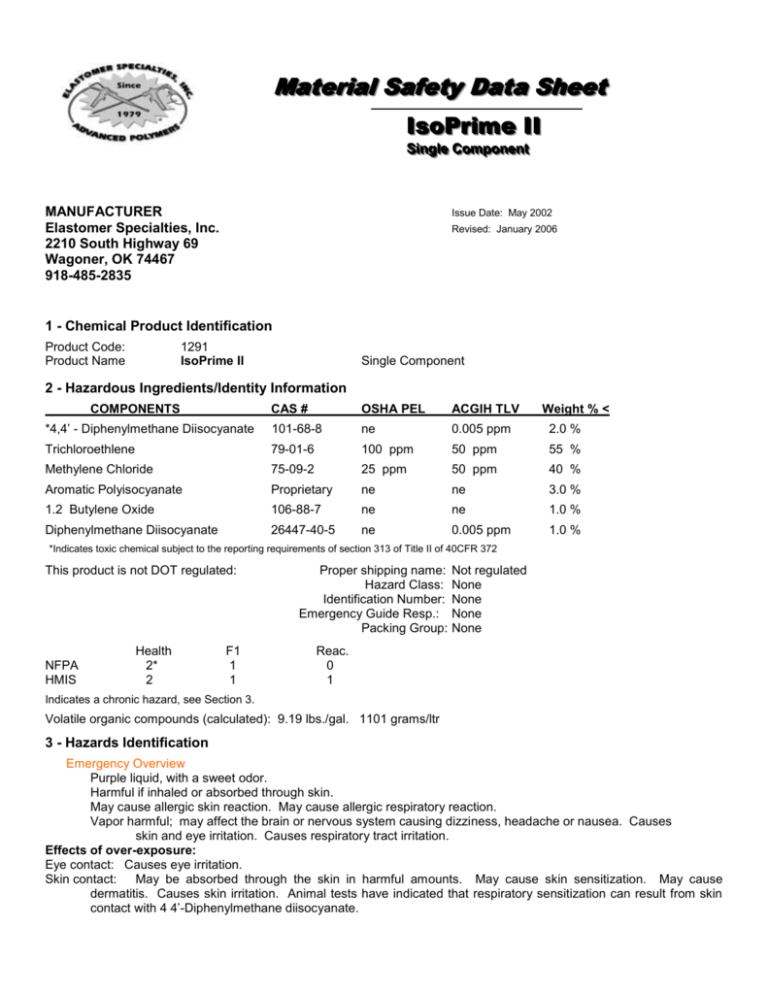
M Ma atte erriia all S Sa affe ettyy D Da atta aS Sh he ee ett IIs so oP Prriim me e IIII SSiinnggllee C Coom mppoonneenntt MANUFACTURER Elastomer Specialties, Inc. 2210 South Highway 69 Wagoner, OK 74467 918-485-2835 Issue Date: May 2002 Revised: January 2006 1 - Chemical Product Identification Product Code: Product Name 1291 IsoPrime II Single Component 2 - Hazardous Ingredients/Identity Information COMPONENTS CAS # OSHA PEL ACGIH TLV Weight % < *4,4’ - Diphenylmethane Diisocyanate 101-68-8 ne 0.005 ppm 2.0 % Trichloroethlene 79-01-6 100 ppm 50 ppm 55 % Methylene Chloride 75-09-2 25 ppm 50 ppm 40 % Aromatic Polyisocyanate Proprietary ne ne 3.0 % 1.2 Butylene Oxide 106-88-7 ne ne 1.0 % Diphenylmethane Diisocyanate 26447-40-5 ne 0.005 ppm 1.0 % *Indicates toxic chemical subject to the reporting requirements of section 313 of Title II of 40CFR 372 This product is not DOT regulated: NFPA HMIS Health 2* 2 F1 1 1 Proper shipping name: Hazard Class: Identification Number: Emergency Guide Resp.: Packing Group: Not regulated None None None None Reac. 0 1 Indicates a chronic hazard, see Section 3. Volatile organic compounds (calculated): 9.19 lbs./gal. 1101 grams/ltr 3 - Hazards Identification Emergency Overview Purple liquid, with a sweet odor. Harmful if inhaled or absorbed through skin. May cause allergic skin reaction. May cause allergic respiratory reaction. Vapor harmful; may affect the brain or nervous system causing dizziness, headache or nausea. Causes skin and eye irritation. Causes respiratory tract irritation. Effects of over-exposure: Eye contact: Causes eye irritation. Skin contact: May be absorbed through the skin in harmful amounts. May cause skin sensitization. May cause dermatitis. Causes skin irritation. Animal tests have indicated that respiratory sensitization can result from skin contact with 4 4’-Diphenylmethane diisocyanate. Elastomer Specialties, Inc. MSDS IsoPrime II Page 2 Inhalation: Possible irritation of the respiratory system can occur causing a variety of symptoms such as dryness of the throat, tightness of the chest, and shortness of breath. May cause central nervous system depression characterized by the following progressive steps: headache, dizziness, staggering gait, confusion, unconsciousness or coma. Allergic conditions can occur in certain individuals with high sensitivity to isocyanates; this may result in asthma-like symptoms. May cause respiratory sensitization. May cause lung damage. Contains methylene chloride. Excessive exposure may cause carboxyhemoglobinemia, a condition which impairs the blood’s ability to transport oxygen. Very high levels of exposure to methylene chloride may cause cardiac arrhythmias. Ingestion: Harmful if swallowed. Ingestion is not an expected route of entry in industrial or commercial uses. Chronic hazards: May cause liver or kidney damage. Repeated or prolonged solvent over- exposure may result in permanent nervous system damage. May cause long-term lung damage. Methylene chloride has been classified for carcinogenicity by IARC and by NTP as sufficient evidence for carcinogenicity in experimental animals; insufficient evidence in humans. Use of this product should comply with the OSHA Mehtylene Chloride Standard, 29CFR1910.1052. Chronic skin contact may cause dermatitis. IARC has designated trichloroethylene as Group 2A - limited evidence for carcinogenicity in humans and sufficient evidence in experimental animals. 1,2 butylene oxide has been classified by IARC as a possible human carcinogen (Group 2B). Primary Route (s) of Entry: Skin contact, skin absorption, inhalation, ingestion, eye contact. 4 - First Aid Measures Eye contact: Flush eyes immediately with large amounts of water for at least 15 minutes holding eyelids open while flushing. Get prompt medical attention. Skin contact: Flush contaminated skin with large amounts of water while removing contaminated clothing. Wash affected skin areas with soap and water. Get medical attention if symptoms occur. Inhalation: Move person to fresh air. Restore and support continued breathing. If breathing is difficult give oxygen. Get immediate medical attention. Ingestion: If swallowed, do not induce vomiting. Give victim one or two glasses of water or milk. Call physician or poison control center immediately for further instructions. Never give anything by mouth to an unconscious person. 5 - Physical/Chemical Characteristics Boiling Point: Vapor Pressure (mm Hg.): Vapor Density (Air=1): Melting Point: Evaporation rate (H2O=1): Solubility in Water: Specific Gravity (H2O= 1) Appearance and Odor: 104°F - 189°F Not determined >1 No Data Slower than Eth Insoluble 1.37 Purple Freeze Point: Volatile by Weight: Density, Lb./Gal. pH: Odor Threshold: Volatile by Volume: Physical State: Odor: Not determined 86.3% 11.38 Not applicable Not determined 84.5% Liquid Sweet 6 - Fire & Explosion Hazard Data Flash Point (Setaflash Closed Cup): >200°F Flammable Limits: Not established Lower Exposure Limit 1.5 % Upper Exposure Limit 44.80 % Extinguishing Media: Carbon Dioxide, Dry chemical, foam, water fog. Auto Ignition Temperature: Not determined. OSHA Flammability Classification: Combustible liquid—Class IIIB Special fire fighting procedures: Wear full firefighting protective clothing, including self-contained breathing apparatus (SCBA). Water spray may be ineffective. If water is used, fog nozzles are preferable. During a fire irritating and/or toxic gases and particulate may be generated by thermal decomposition or combustion. Unusual fire and explosion hazards: Keep containers tightly closed. Closed containers may rupture when exposed to extreme heat. Use water spray to keep fire exposed containers cool. 7 - Reactivity Data Stability: Product is stable under normal storage conditions. Incompatibility: Amines, acids, water, hydroxyl, or active hydrogen compounds. Aluminum, zinc, caustics, halogens. Hazardous decomposition or by products: Monomeric isocyanate, traces of hydrogen cyanide, nitrogen dioxide. Phosgene. Carbon monoxide, carbon dioxide. Issue Date: May 2002 Revised: January 2006 2210 South Highway 69, Wagoner, OK 74467 · (918) 485-2835 · Fax: (918) 485-2856 Elastomer Specialties, Inc. MSDS IsoPrime II Page 3 Polymerization: Hazardous polymerization will not occur under normal conditions. Conditions to avoid: Aluminum or galvanized parts in a closed system. High temperatures. 8 - Spill or Leakage Procedures If material is spilled or released: Keep non-essential personnel a safe distance away from the spill area. Avoid breathing vapors. Use self-contained breathing equipment. Notify appropriate authorities if necessary. Contain and remove spill with inert material (sand). Avoid personal contact. Before attempting cleanup, refer to hazard caution information in other sections of the MSDS form. Disposal method: Dispose of according to local, state, and federal regulations. Not a hazardous waste under RCRA, 40 CFR 261. Not RCRA regulated. If waste is determined to be hazardous, use licensed hazardous waste transporter and disposal facility. Handling and storage: Keep closure tight and container upright to prevent leakage. Avoid skin and eye contact. Wash thoroughly after handling. Avoid breathing of vapor or spray mists. Do not handle until all safety precautions have been read and understood. Empty containers should not be re-used. Avoid using pressurizable equipment which has aluminum or zinc parts, this product contains chlorinated solvents. Use with adequate ventilation. 9 - Special Protection Information Respiratory: This product contains isocyanates which have poor odor warning properties. If occupational exposure limits are exceeded, a NIOSH/MSHA approved supplied-air respirator is required. Contains methylene chloride, which has poor odor warning properties. Observe OSHA regulations (29CFR 1910.134) Ventilation: Sufficient ventilation in pattern and volume should be provided in order to maintain air contaminant levels below recommended exposure limits. Caution: solvent vapors are heavier than air and collect in lower levels of the work area. Protective Gloves: Neoprene, nitrile, or rubber gloves are recommended to prevent skin contact. Other Protective Clothing or Equipment: Safety glasses, chemical goggles, or face shields are recommended. Use disposable or impervious clothing if work clothing contamination is likely. Remove and wash contaminated clothing before reuse. Work/Hygienic Practices: Wash thoroughly after handling. Wash hands before eating, smoking, or using toilet facility. Do not smoke in any chemical handling or storage area. Food or beverages should not be consumed anywhere this product is handled or stored. 10 - Toxicological and Ecological Information Product LD50 Product LC50 Oral: No data Dermal: No data No data Ecological Information: No information 11 - Regulatory Information U.S. Federal Regulations as follows: OSHA: Hazardous by definition of Hazard Communication Standard (29 CFR 1910.1200) SARA Section 313: This product contains the following substances subject to the reporting requirements of Section 313 of Title III of the Superfund Amendment and Reauthorization Act of 1986 and 40 CFR part 372: Elastomer Specialties’ method of hazard communication is comprised of Product Labels and Material Safety Data Sheets. HMIS and NFPA ratings are provided by Elastomer Specialties, Inc. as a customer service. This information is furnished without warranty, expressed or implied, except that it is accurate to the best knowledge of Elastomer Specialties, Inc. The data on this sheet relates only to the specific material designated herein. Elastomer Specialties, Inc. assumes no legal responsibility for use or reliance upon this data. Issue Date: May 2002 Revised: January 2006 2210 South Highway 69, Wagoner, OK 74467 · (918) 485-2835 · Fax: (918) 485-2856

